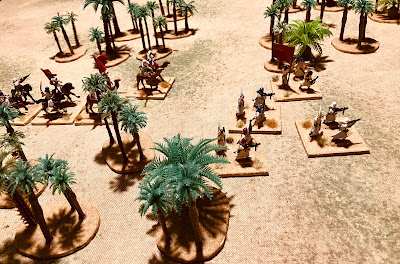A few weeks ago, I purchased several bags of palm trees, which included a variety of sizes. I first based all of the trees that were suitable for my 20mm armies, and over the past week I have now found time to base the smaller palm trees that will be suitable for my 6mm WW2 Western Desert games.
 |
| Recently added palm trees suitable for my 6mm WW2 Western Desert armies |
While on the desert themed terrain I also wanted to make some sand dunes and steeper hills to go with the palm tree groves. I find placing books and bits of wood under my home-made canvas gaming mat unsatisfactory for 6mm units because when looking down at the tabletop it can be unclear when a unit is on or behind a hill.
 |
| The palm trees with a steep hill and sand dune. |
To make the hills and sand dunes I used a pack of four foam fill sheets I found at the local craft store. Each sheet is 12 inches square (300mm) and 3/8 inches (5mm) thick. Using a pair of sharp scissors, and and you do need sharp scissors, I found I could very quickly cut out and shape the hills. To make the steeper hills, I just glued two sheets together with spray adhesive, then cut and shaped them.
 |
| Foam fill used for the hills. |
Painting the hills was very easy and straight forward. In fact I am not not sure I should call it painting, but rather dipping.
- I added my base sand paint and brown to a clear bucket until I achieved the desired colour. Then, I added water until the mixture was more like a wash than paint. I simply dipped all of the foam hills into the wash to colour them.
- After laying them out to dry, but before they were dry, I used a paintbrush to apply a slightly darker brown wash around the edges to create a mottled look.
- Next, I applied a lighter sand color wash to the top.
- Finally, once the hills were dry, I added some green to represent scrub and dry brushed on some sand to highlight the edges.
 |
| On the right is a steep hill of two foam layers stuck together which I can use for escarpments and to the left a lower hill or sand dune. The Panzer III models are 6mm. |
The four foam sheets have provided me with enough steep hills, with their escarpment sides and sand dunes, to cover the tabletop. These hills will provide plenty of opportunities for armoured units to surprise the enemy as they appear from behind the sand dunes and hills.
One benefit of the foam hills is they are easy to store, will not get damaged, and if they end up out of shape they can be easily reworded back into shape. They do adhere well to my canvas tabletop mat and do not slide around.
 |
| All the palm trees and hills. |
With all this new terrain it was time to get a suitable game set up. I through scenario 5 (Bridgehead) from One-Hour Wargames would be good. Instead of a river I have a minefield which has just been breached.
 |
| A game in progress using the OHW bridgehead scenario with a minefield replacing the river in the original scenario. |
The idea of using foam for hills comes from the book Practical Wargaming by C.F.Wesencraft. See below.













































